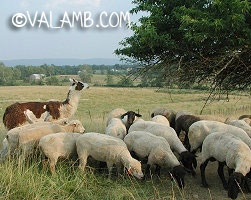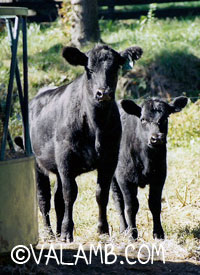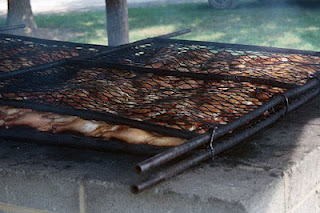There are times when new customers approach us at the farmers market and get frustrated when we don’t have a specific type of meat that they are looking for. Pointing to our canvas sign above the coolers, they remind us that we advertise lamb, goat, beef, pork, and poultry. So where is the {fill in the blank}? Often they totally overlook the word seasonal that precedes our offerings.
We don’t blame them, as most Americans never consider their meat supply as seasonal. Between different climates found in the US, imported meat, the ability to harvest meat within a window of time (think weeks/months vs. hours/days for vegetables), and that wonderful invention we call a freezer we are spoiled. But if you are someone who appreciates local food, it’s time to take a look behind the scenes.
Sheep are wonderful creatures and our favorite livestock here on the farm. As in most places, our sheep naturally lamb in the spring. The spring lamb you eat isn’t really referring to the time it was harvested but when it was born. We have a huge demand for Easter lamb, and, well, that poses a slight problem. Seldom do we have lambs ready by April or May. The bulk of our lambs are born in January and February and most are harvested at 7 to 9 months. That puts them market ready in September, long after Easter. We have been able to meet the needs of our customers by having a few of our lambs born in the fall. But that is not an easy task. Sheep breed based on hours of daylight. And try as we may, most like to {snuggle} with the ram between August and November. Picky aren’t they!
GOAT
Goats are a mystery to us most days. There is not a fence that can keep them in (ask Grandma and she’ll point to her garden). We also have a terrible time getting them to breed on our time schedule. Like sheep they are very sensitive to daylight. Several years back an old farmer told us that goats only breed in months with an “R.” Even after confiscating all their daytimers and removing all calendars from the barn — no success. Kidding aside, they definitely have their own schedule and yes, it appears they only breed in months with an “R.” So if they breed in September and October, kid in February and March, we have goat meat available in the fall. Because our herd is relatively small, we haven’t tried lengthening our breeding season into March and April yet.
PORK
We have tried our hand at breeding pigs. We choose two beautiful sows that the kids showed one year. They were calm, easy going, would walk anywhere you wanted them to go. Then they farrowed. And instantly they turned into kill-you-if-they-could beasts. Mean didn’t begin to describe them. With little kids around, we quickly got back out of the pig business. Now we purchase a group of weaned piglets each spring and fall to raise. Traditionally pork is harvested in the fall when farmers came together as a community for harvesting. The men would scald, hang, and cut up the pork. The women would make sausage, scrapple, and organ meats. It was a flurry of activity. The weather was cool enough to smoke hams and bacon, and it wasn’t so blistering hot over the boiling kettles. Pigs will actually breed any time of year. Our decision for mostly spring born pigs is for two reasons. Our kids like showing market hogs at the county fair in late August. And Farmer (Corey’s Dad) still likes to take an occasional pig to the old timers pig harvest.
Finally, here is an animal that is eager to please. Cows breed year round and thus should be able to supply us with beef year round. Like most farmers in Virginia we run a cow/calf operation. Meaning we have a herd of mature cows that calve each year. We then sell the weaned calves as our income source. Ideally calves are all born at the same time so that weaning can be done all at once providing us with a uniform a group to market (uniform equates to higher market prices). Although we do not mind calving the herd in smaller groups throughout the year, there is a snag. Grass is most abundant during the spring. Momma cows eat a lot of grass — a must to produce the milk needed to feed their young calves. Spring is the best time to provide enough green, lush grass for milking cows in a pasture raised system. So it is much cheaper and more efficient to calve in the spring. Our calves are harvested at 18 months, thus giving us our best supplies in the fall.
POULTRY
Most breeds of chickens lay eggs year round. Yeah! Now there is a protein source twelve months a year. They definite drop off in production during the winter months, daylight being the culprit, but they do lay eggs in the winter. Eggs can be incubated year round. Chicks can be born year round. Broilers can be raised year round. The only down side is that there isn’t sustainable pasture in the winter months and they must be supplemented with additional feed. Also cold, drafty, damp weather can be stressful if they are not properly protected. So when you stop by our farm stand and all we have are chicken and eggs, you now know why.
It is the cycle of life, as most species birth in the spring when natural feed sources are most abundant. As producers we try to control our meat supplies the best we can. But part of subscribing to sustainable agriculture is being able to except what nature does best on its own. So the next time you are enjoying summer grown tomatoes or corn on the cob, we hope you will now add meat to the “seasonal” category too.
Each of us associates particular foods with certain times of the year. I love spicy sausage links fresh from the butcher with sauerkraut and creamy potato soup on the first chilly day in autumn. What is your favorite seasonal meat dish?


